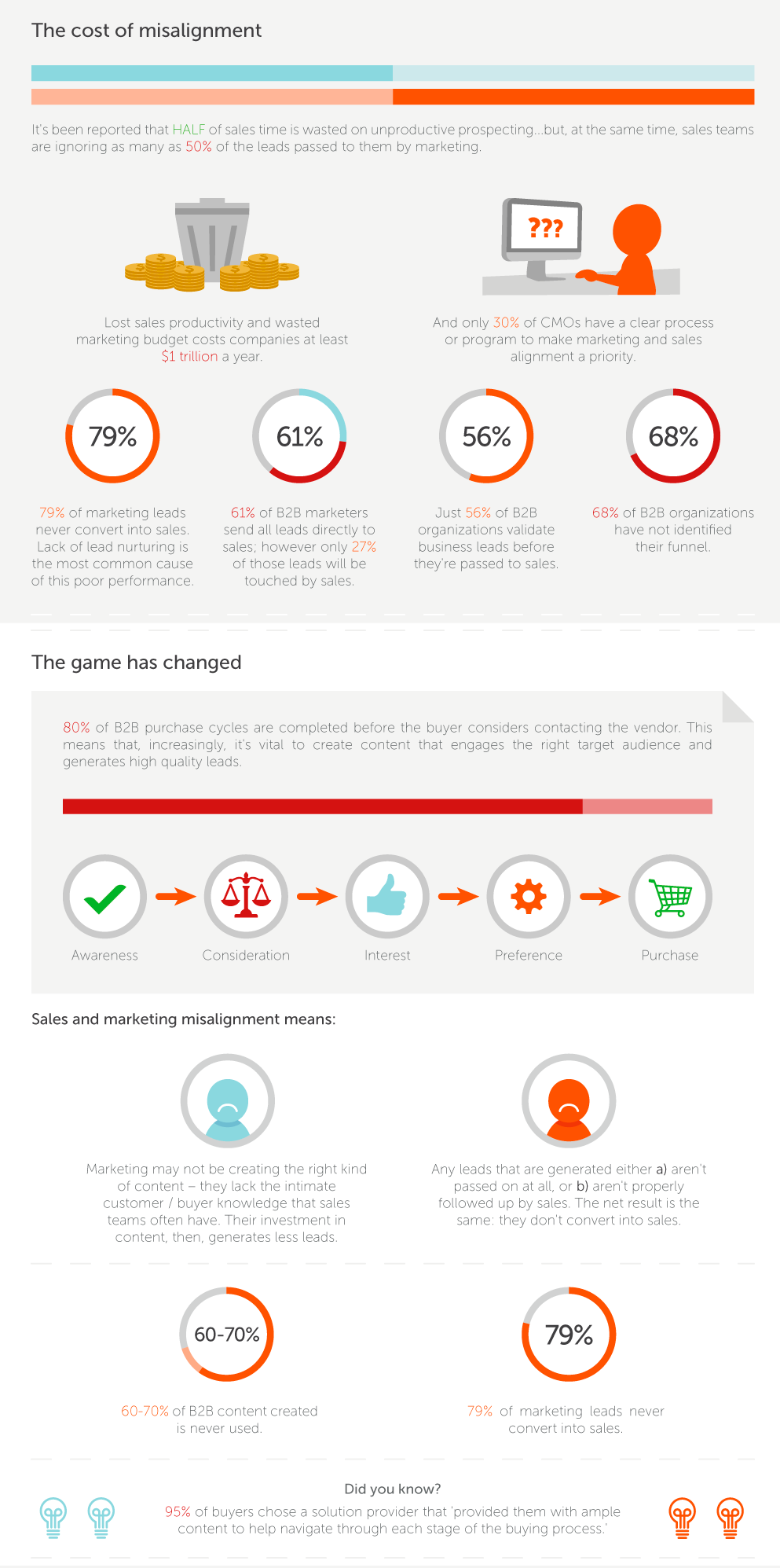Tried-and-True Tips for Sales and
Marketing Alignment
Firstly, What Is Sales And Marketing Alignment?
Sales and marketing alignment, or “smarketing” as some like to call it, is essentially getting these two teams to cooperate as one; working towards a common goal – generating and increasing revenue in the long run.
Think of your business as one big family. As with real families, there are usually two or more relations (like siblings) who are constantly bickering, and in this instance, Sales and Marketing can be considered the corporate siblings.
Aligning these two teams is an opportunity to grow your business. As a sales or marketing manager (or parent in this instance), it can be frustrating to constantly try and keep the peace between the two teams, especially when your time could be better spent on more productive tasks.
Getting these “siblings” to collaborate and listen yields a brand new invention – or simply creates a much more harmonious working environment. Which in turn leads to a healthy impact on organisational growth (see more on this infographic by Wheelhouse advisors).

Did you know that $1 trillion of revenue is lost annually due to marketing misalignment?
Let’s explore some ways on how to better align your marketing and sales teams.
Spot The Difference
Sales and marketing teams are often siloed through different offices, technologies and goals. By (literally) breaking down the walls between these two teams, you can combine the sales and marketing funnels into one process for both teams. How? With Microsoft Dynamics 365 for Sales and Marketing. Both of these software solutions are based on the same platform so that both teams can share and access data and business processes – simplifying the alignment between sales and marketing teams.
Practice What You Preach
As the leader of your team, you should practice what you preach. Openly praising (or criticizing) another team in front of your own will set the precedent for them to do the same. Small, simple ways to start the alignment process are by giving credit where it’s due; openly collaborating with other team leaders and carrying their contributions back to your own team. When your team sees your cooperation with the other, the effect will trickle down.
Check-In Regularly
Another way to align the sales and marketing teams is to simply communicate with one another. It can be as quick as grabbing a coffee together or through scheduled meetings. This essentially helps the team gain in-depth knowledge of one another’s challenges. Attending meetings together lets teams know how each one is doing with their goals and how they can support one another. For example, the marketing team can share what content they’re creating and promoting, while the sales team can help marketing improve their lead-generating skills.
Generate Quality Leads Together
In order to generate strong quality leads, both the marketing and sales teams need to align on what the ideal client looks like. If this is not clear, marketing campaigns could be skewed and sales will waste time chasing misinformed leads. Assessing your buyer persona together ensures more accurate marketing campaigns and higher close rates for the sales team, and ultimately increased revenue. A win for everyone!
Feedback Drives Improvement
Smarketing needs to head toward the same goal with the same coordinated messaging, and as long as each department is doing this, everyone will be aligned. Keeping an open feedback loop to ensure everyone is on the same page is imperative to achieving alignment and organisational growth. For example, should a prospect or customer ask for content that doesn’t exist (yet), there should be a simple way for marketing to receive this nudge and add it into their content strategy. Similarly, sales should ensure they’re using defined brand tone/messaging when prospecting. This type of open communication drives improvement across both teams.
Be A Motivator
Though it may seem to be the most obvious route to alignment, motivation hardly seems to be the first thought that comes to mind. By motivating everyone on your team – from the CEO to the new intern – you’ll get a better understanding of the financial value of their work.
Set Common Goals
Creating similar KPIs and goals is a great way to align smarketing. Having the same goal gets both teams working and strategising together, providing a more holistic approach to marketing. This also creates a seamless transition from marketing to sales, preventing broken messaging that could result in losing a potential lead. When conversion rates and lead value is measured and influenced by both teams, this would be a great key performance indicator (KPI) smarketing can work towards.
Understanding What Each Team Wants
There will naturally be different KPIs for each team and colleague, but for true smarketing alignment, there needs to be a general understanding of what each team wants to achieve and how they can work together to achieve it. Perhaps it comes down to the sales team reducing the number of touchpoints between converting a lead to a sale. By collaborating with the marketing team, they can create succinct workflows that allow leads to pass between marketing and sales, as and when necessary.
So, there you have it – tried and true tips for aligning your sales and marketing teams; these tips should help your teams get along effortlessly. But remember, implementing the same tools such as Microsoft Dynamics 365 for Sales and Marketing, having the same processes and aligning your goals is key. When one team is working with leads from the other, data can get lost on both sides and teams can’t see where the lead originated from, track its progress or provide feedback on trends surrounding these leads.
Now that there’s virtually nothing holding you back, see what you can do to improve smarketing alignment today – we suggest starting with a coffee, a chat and Microsoft Dynamics 365.
Transform your business
Don’t miss more articles by The CRM Team
Breaking Down Silos: How monday.com Unifies Teams Across Departments
Breaking Down Silos: How monday.com Unifies Teams Across DepartmentsIn today’s fast-paced business environment, the biggest roadblock to efficiency isn’t just outdated processes—it’s siloed teams. Different departments often operate in isolation, leading to...
Avoiding common mistakes when adopting monday.com
Avoiding common mistakes when adopting monday.com - Unlock Its Full Potential for Business Successmonday.com has transformed how businesses manage projects, workflows, and team collaboration. It’s a powerful Work OS that promises automation, real-time insights, and...
Avoiding Pitfalls and Ensuring Success in Dynamics 365 Customer Engagement Implementation
Avoiding Pitfalls and Ensuring Success in Dynamics 365 Customer Engagement Implementation by Taryn EngelbrechtImplementing Dynamics 365 Customer Engagement can be a game-changer for organizations looking to enhance their digital presence and improve customer...


